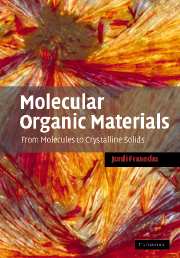Book contents
- Frontmatter
- Contents
- Preface
- List of abbreviations and symbols
- List of chemical abbreviations
- 1 An introduction to molecular organic materials
- 2 Building molecules: molecular engineering
- 3 Building materials: crystal engineering
- 4 Interfaces
- 5 Thin-film growth: from 2D to 3D character
- 6 A miscellany of physical properties
- Afterword
- Appendix A
- Appendix B
- References
- Index
Afterword
Published online by Cambridge University Press: 23 November 2009
- Frontmatter
- Contents
- Preface
- List of abbreviations and symbols
- List of chemical abbreviations
- 1 An introduction to molecular organic materials
- 2 Building molecules: molecular engineering
- 3 Building materials: crystal engineering
- 4 Interfaces
- 5 Thin-film growth: from 2D to 3D character
- 6 A miscellany of physical properties
- Afterword
- Appendix A
- Appendix B
- References
- Index
Summary
… que tot està per fer i tot és possible.
Miquel Martí i Pol, Ara mateixWe discussed in Section 1.1 the complexity that a rather simple molecule such as N2 can manifest when it is made to form 2D and 3D periodic and non-periodic structures. This system was used to introduce the myriad molecules that we have been studying throughout this book and now it will help us to conclude. Given that solid nitrogen becomes semiconducting at the elevated pressure of 240 GPa, we can ask ourselves if, from the practical point of view, solid nitrogen is of any use. It is clear that it is hard to find technological applications in these extreme conditions, unless somebody dreams of making business on distant planets or stars. However, the important point is the scientific knowledge that is acquired working with almost any system, no matter how difficult it is. Unfortunately, many scientists fancy themselves as pseudo-technologists mainly because of the desperate search for financial funding. This means that the fabulous science behind the studied systems is not fully explored and that the claims for incredible applications usually remain as claims. Science and technology should go hand in hand, but scientists should have enough free rein to explore the unknown. The results always come.
Sometimes, among the MOMs community one gets the feeling that this field is losing strength, with many scientists getting bored of obtaining and characterizing similar materials with similar properties and hurrying to publish the results. I do not share this opinion. In fact, and I hope I have made it clear in this book, only a few systems out of an incredibly large number are well known, though not completely characterized.
- Type
- Chapter
- Information
- Molecular Organic MaterialsFrom Molecules to Crystalline Solids, pp. 307 - 308Publisher: Cambridge University PressPrint publication year: 2006

